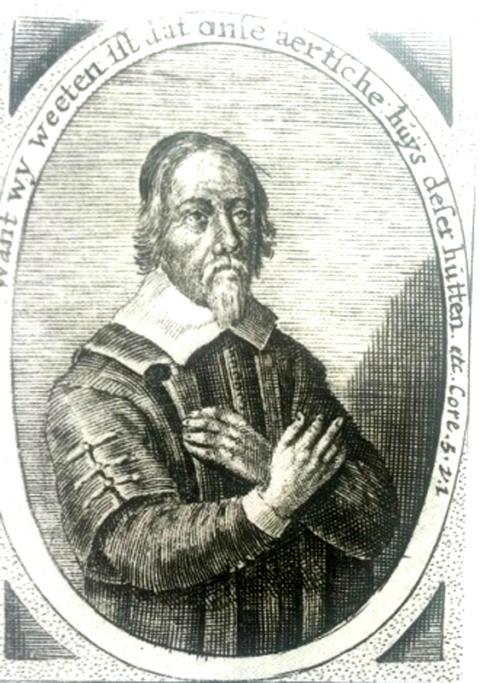On Saturday, Taiwan was the focus of activities in Schipluiden, a small village between The Hague and Rotterdam in The Netherlands.
The occasion was the unveiling of a monument commemorating Reverend Anthonius Hambrouck, who was a pastor in the old church in the village from 1632 until 1647, when Hambrouck left with his wife and four children, and sailed to faraway Formosa (a journey of almost one year). The church and the pulpit in the church remain the same as when Hambrouck left in 1647.
In Formosa, the Dutch East India Company had established its Fort Zeelandia in 1624 and built up a prosperous colony. Part of the work of the colony was to bring the gospel to the Aboriginal Siraya people, and establish schools and medical clinics in the area around today’s Anping (安平) in Tainan.

photo courtesy of Gerrit Van Der Wees
The first pastor to work in the area was Reverend George Candidius, who arrived in 1627 but refused to live at the fort, and instead made Sincan (present-day Sinshih District, 新市區) his home.
When Hambrouck arrived in 1647, he set up his parish in Mattau (today’s Madou District, 麻豆區) which in the early years had been hostile to the incoming Dutch — and at war with neighboring villages such as Sincan — when Candidius had been the pastor.
Hambrouck started preaching, and also began a school, and initially had some 145 male students, who received education “from the cock’s crowing.” The education gradually expanded, and Hambrouck started classes for girls and women in the afternoon. He trained a number of Aboriginal men as assistant teachers.

photo courtesy of Gerrit Van Der Wees
The ceremony in Schipluiden honored Hambrouck for his work, and particularly his role in establishing the written version of the Siraya language, which is currently undergoing revival efforts.
The plaque that was jointly unveiled by Taiwan representative Tom Chou (周台竹) and current Schipluiden pastor Erika Dibbets-van der Roest shows text taken from the Bible’s Gospel of St. Matthew in both old-Dutch and the Siraya language. The piece of art was a work by a former resident of Schipluiden, Marcel Koeleman.
The village of Schipluiden also decided to honor Reverend Hambrouck by naming the square in front of the church “Hambrouckplein” (Hambrouck square). The mayor of the village, Arnoud Rodenburg, and the town’s councilmember for culture and monuments Wendy Renzen jointly unveiled the new name plate.
Hambrouck became most famous in his role as intermediary after the landing of Cheng Cheng-kung (鄭成功, also known as Koxinga) in late April 1661. Koxinga and his 25,000 invading troops had been able to occupy the countryside area around Fort Zeelandia, but not the heavily defended fort itself.
Koxinga arrested and imprisoned some 500 Dutch who lived in the 40 villages around Fort Zeelandia, and selected Hambrouck to go to the fort and ordered him to convince Governor-General Frederic Coyett to surrender. Koxinga kept Hambrouck’s wife, one daughter and son as hostages. The other two married daughters lived at the fort.
When Hambrouck met Coyett, he urged him not to surrender, but to hold out until reinforcements from Batavia (present day Jakarta) would arrive. His two daughters at the castle begged him to stay (a big painting at today’s Anping Old Fort depicts the scene), but Hambrouck wanted to safeguard the lives of his wife and son and daughter, and returned to Koxinga’s headquarters at Fort Provintia, handing Koxinga the negative answer of Coyett. Koxinga subsequently had Hambrouck killed.

In Taiwan there are two economies: the shiny high tech export economy epitomized by Taiwan Semiconductor Manufacturing Co (TSMC, 台積電) and its outsized effect on global supply chains, and the domestic economy, driven by construction and powered by flows of gravel, sand and government contracts. The latter supports the former: we can have an economy without TSMC, but we can’t have one without construction. The labor shortage has heavily impacted public construction in Taiwan. For example, the first phase of the MRT Wanda Line in Taipei, originally slated for next year, has been pushed back to 2027. The government

July 22 to July 28 The Love River’s (愛河) four-decade run as the host of Kaohsiung’s annual dragon boat races came to an abrupt end in 1971 — the once pristine waterway had become too polluted. The 1970 event was infamous for the putrid stench permeating the air, exacerbated by contestants splashing water and sludge onto the shore and even the onlookers. The relocation of the festivities officially marked the “death” of the river, whose condition had rapidly deteriorated during the previous decade. The myriad factories upstream were only partly to blame; as Kaohsiung’s population boomed in the 1960s, all household

Allegations of corruption against three heavyweight politicians from the three major parties are big in the news now. On Wednesday, prosecutors indicted Hsinchu County Commissioner Yang Wen-ke (楊文科) of the Chinese Nationalist Party (KMT), a judgment is expected this week in the case involving Hsinchu Mayor Ann Kao (高虹安) of the Taiwan People’s Party (TPP) and former deputy premier and Taoyuan Mayor Cheng Wen-tsan (鄭文燦) of the Democratic Progressive Party (DPP) is being held incommunicado in prison. Unlike the other two cases, Cheng’s case has generated considerable speculation, rumors, suspicions and conspiracy theories from both the pan-blue and pan-green camps.

Stepping inside Waley Art (水谷藝術) in Taipei’s historic Wanhua District (萬華區) one leaves the motorcycle growl and air-conditioner purr of the street and enters a very different sonic realm. Speakers hiss, machines whir and objects chime from all five floors of the shophouse-turned- contemporary art gallery (including the basement). “It’s a bit of a metaphor, the stacking of gallery floors is like the layering of sounds,” observes Australian conceptual artist Samuel Beilby, whose audio installation HZ & Machinic Paragenesis occupies the ground floor of the gallery space. He’s not wrong. Put ‘em in a Box (我們把它都裝在一個盒子裡), which runs until Aug. 18, invites